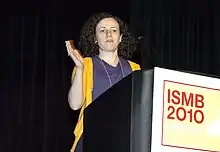Olga Troyanskaya | |
|---|---|
 Olga Troyanskaya speaking at ISMB 2010 | |
| Born | Olga G. Troyanskaya |
| Alma mater |
|
| Awards | Overton Prize (2011)[1] |
| Scientific career | |
| Fields | |
| Institutions | |
| Thesis | Improving the specificity of biological signal detection from microarray data |
| Doctoral advisor | |
| Doctoral students | Curtis Huttenhower[4][5] |
| Website | function |
Olga G. Troyanskaya is a Professor in the Department of Computer Science and the Lewis-Sigler Institute for Integrative Genomics at Princeton University and the Deputy Director for Genomics at the Flatiron Institute's Center for Computational Biology in NYC.[6] She studies protein function and interactions in biological pathways by analyzing genomic data using computational tools.[2][7][8][9][10][11][12]
Education
Troyanskaya completed her Bachelor of Science degree in Computer Science and Biology at the University of Richmond in 1999 and her Ph.D. Biomedical Informatics at Stanford University in 2003.[1][3][13]
Awards
In 2011, she was awarded the Overton Prize from the International Society for Computational Biology (ISCB).[14] In 2014, she was awarded the Ira Herskowitz Award from the Genetics Society of America.[15] In 2017, she was elected as a Fellow of the ISCB.[16] In 2020, she was elected Fellow of the Association for Computing Machinery (ACM) " for contributions to computational biology and data integration."[17]
References
- 1 2 3 Mullins, J.; Morrison Mckay, B. (2011). "International Society for Computational Biology Honors Michael Ashburner and Olga Troyanskaya with Top Bioinformatics/Computational Biology Awards for 2011". PLOS Computational Biology. 7 (6): e1002081. Bibcode:2011PLSCB...7E2081M. doi:10.1371/journal.pcbi.1002081. PMC 3107244.
- 1 2 Olga Troyanskaya publications indexed by Google Scholar
- 1 2 Troyanskaya, Olga (2003). Improving the specificity of biological signal detection from microarray data (PhD thesis). Stanford University. ProQuest 305300710.
- ↑ Fogg, Christiana N.; Kovats, Diane E. (2015). "2015 ISCB Overton Prize Awarded to Curtis Huttenhower". PLOS Computational Biology. 11 (6): e1004319. Bibcode:2015PLSCB..11E4319F. doi:10.1371/journal.pcbi.1004319. ISSN 1553-7358. PMC 4466272. PMID 26067840.

- ↑ Huttenhower, Curtis (2009). Analysis of large genomic data collections (PhD thesis). Princeton University. OCLC 298182845.
- ↑ "Olga Troyanskaya". 4 November 2014.
- ↑ Troyanskaya, O. G.; Dolinski, K.; Owen, A. B.; Altman, R. B.; Botstein, D. (2003). "A Bayesian framework for combining heterogeneous data sources for gene function prediction (in Saccharomyces cerevisiae)". Proceedings of the National Academy of Sciences. 100 (14): 8348–8353. Bibcode:2003PNAS..100.8348T. doi:10.1073/pnas.0832373100. PMC 166232. PMID 12826619.
- ↑ Troyanskaya, O.; Cantor, M.; Sherlock, G.; Brown, P.; Hastie, T.; Tibshirani, R.; Botstein, D.; Altman, R. (2001). "Missing value estimation methods for DNA microarrays". Bioinformatics. 17 (6): 520–525. doi:10.1093/bioinformatics/17.6.520. PMID 11395428.
- ↑ Garber, M. E.; Troyanskaya, O. G.; Schluens, K.; Petersen, S.; Thaesler, Z.; Pacyna-Gengelbach, M.; Van De Rijn, M.; Rosen, G. D.; Perou, C. M.; Whyte, R. I.; Altman, R. B.; Brown, P. O.; Botstein, D.; Petersen, I. (2001). "Diversity of gene expression in adenocarcinoma of the lung". Proceedings of the National Academy of Sciences. 98 (24): 13784–13789. Bibcode:2001PNAS...9813784G. doi:10.1073/pnas.241500798. PMC 61119. PMID 11707590.
- ↑ Olga G. Troyanskaya at DBLP Bibliography Server
- ↑ Olga Troyanskaya publications indexed by Microsoft Academic
- ↑ Olga Troyanskaya's publications indexed by the Scopus bibliographic database. (subscription required)
- ↑ https://function.princeton.edu/media/documents/troyanskaya_cv.pdf Olga Troyanskaya CV
- ↑ "Overton Prize winners".
- ↑ "Yeast Genetics Meeting 2014". Archived from the original on 2018-07-15. Retrieved 2014-09-15.
- ↑ "February 13, 2017: The International Society for Computational Biology Names Seven Members as the ISCB Fellows Class of 2017". www.iscb.org. Retrieved 13 February 2017.
- ↑ "ACM Fellows" (PDF). Notices of the American Mathematical Society. 68: 832.